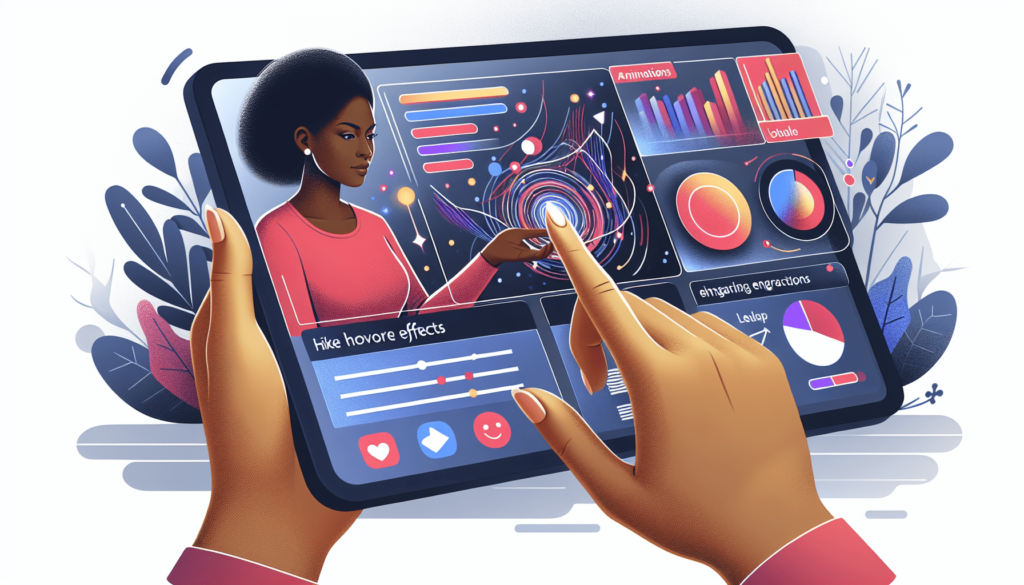Have you ever wondered how to increase user engagement on your website?
If you are looking for innovative ways to captivate your audience and keep them interested, interactive infographics may be the answer you are looking for. By incorporating interactive elements into your infographics, you can provide an engaging and immersive experience for your visitors, leading to increased interaction and retention on your website.

What exactly are interactive infographics?
Interactive infographics are a dynamic and interactive way to present information using a combination of text, images, and interactive elements. Unlike traditional static infographics, interactive infographics allow users to engage with the content by clicking, dragging, scrolling, and exploring the data in a more hands-on and personalized manner.
How can interactive infographics enhance user engagement?
Interactive infographics have the power to capture the attention of your audience and encourage them to explore and interact with your content. By providing a more engaging and interactive experience, you can increase the time users spend on your website, reduce bounce rates, and improve overall user engagement.
What are some key benefits of using interactive infographics?
There are several key benefits to incorporating interactive infographics into your website:
- Increased Engagement: Interactive infographics can captivate your audience and encourage them to interact with your content, leading to increased engagement and retention.
- Improved User Experience: By providing a more dynamic and interactive experience, you can enhance the overall user experience on your website.
- Higher Information Retention: Interactive elements make it easier for users to understand and retain information, leading to better knowledge retention.
- Enhanced Visual Appeal: Interactive infographics are visually appealing and can help you stand out from the competition.
- Boosted SEO: Interactive infographics can also contribute to improved search engine optimization by increasing user engagement and time spent on your website.
How can you create interactive infographics for your website?
Creating interactive infographics may seem like a daunting task, but there are several user-friendly tools and platforms available that can help you bring your ideas to life. Here are some steps to help you get started:
- Plan Your Content: Determine the key message you want to convey and the data you want to present in your infographic.
- Choose a Tool or Platform: There are several tools and platforms available that can help you create interactive infographics, such as Visme, Canva, and Piktochart.
- Design Your Infographic: Use a combination of text, images, and interactive elements to create a visually appealing and engaging infographic.
- Add Interactive Elements: Incorporate interactive elements such as clickable buttons, animations, hover effects, and more to enhance user engagement.
- Test and Optimize: Test your interactive infographic on different devices and browsers to ensure compatibility and optimize for performance.
- Publish and Promote: Once your infographic is ready, publish it on your website and share it on social media to reach a wider audience.

What are some popular interactive elements to include in your infographics?
There are several interactive elements that you can incorporate into your infographics to make them more engaging and interactive:
- Clickable Buttons: Allow users to click on buttons to navigate through the content or access additional information.
- Animations: Add animations to bring your infographic to life and make it more visually appealing.
- Hover Effects: Use hover effects to reveal hidden information when users hover over specific areas of the infographic.
- Drag-and-Drop Interactions: Enable users to drag and drop elements to explore the data in a more hands-on manner.
- Interactive Charts and Graphs: Include interactive charts and graphs that users can interact with to view data dynamically.
- Audio and Video Elements: Incorporate audio and video elements to provide additional context and engagement.
How can interactive infographics help you achieve your marketing goals?
Interactive infographics can be a powerful tool to help you achieve your marketing goals and drive results for your business. Here are some ways interactive infographics can benefit your marketing strategy:
- Increased Brand Awareness: Interactive infographics can help you increase brand awareness by providing valuable and engaging content that users are more likely to share.
- Lead Generation: By creating interactive infographics that require users to provide their contact information to access, you can generate leads for your business.
- Improved Conversion Rates: Interactive infographics can help you educate and inform users about your products or services, leading to improved conversion rates.
- Social Media Engagement: Interactive infographics are highly shareable on social media, making them an effective way to engage with your audience and drive traffic to your website.
- Data Collection: Interactive infographics can also help you collect valuable data about your audience’s preferences and behaviors, which can inform your marketing strategies.
How can you measure the effectiveness of your interactive infographics?
Measuring the effectiveness of your interactive infographics is essential to understand how they are performing and make improvements for future campaigns. Here are some key metrics you can use to measure the success of your interactive infographics:
- Engagement Metrics: Monitor metrics such as time spent on page, scroll depth, click-through rates, and bounce rates to gauge user engagement.
- Social Shares: Track the number of shares, likes, comments, and mentions your interactive infographics receive on social media platforms.
- Conversion Rates: Measure how many users who interacted with your interactive infographics took a desired action, such as signing up for a newsletter or making a purchase.
- Traffic Sources: Analyze where your traffic is coming from and which channels are driving the most engagement with your interactive infographics.
- Feedback and Surveys: Collect feedback from users through surveys or polls to understand their preferences and make improvements to your interactive infographics.
What are some best practices for creating interactive infographics?
To create effective and engaging interactive infographics, follow these best practices:
- Keep It Simple: Avoid overwhelming users with too much information or complex interactive elements. Keep your infographic clear, concise, and easy to navigate.
- Tell a Story: Use a narrative structure to guide users through the content and make it more engaging and memorable.
- Visual Consistency: Maintain visual consistency throughout your infographic by using a cohesive color scheme, typography, and design elements.
- Mobile Optimization: Ensure your interactive infographic is optimized for mobile devices to provide a seamless user experience across different devices.
- Accessibility: Make sure your interactive infographic is accessible to users with disabilities by including alt text, keyboard navigation, and other accessibility features.
- Promotion: Promote your interactive infographic through social media, email marketing, and other channels to reach a wider audience and increase engagement.
How can you incorporate interactive infographics into your content strategy?
Interactive infographics can be a valuable addition to your content strategy, helping you deliver information in a more engaging and interactive format. Here are some ways you can incorporate interactive infographics into your content strategy:
- Educational Content: Use interactive infographics to explain complex concepts, showcase data, or provide step-by-step guides to educate your audience.
- Product Demonstrations: Create interactive infographics to demonstrate how your products or services work and highlight their key features and benefits.
- Industry Reports: Present industry trends, statistics, and insights in an interactive format to engage your audience and provide valuable information.
- Case Studies: Use interactive infographics to showcase your success stories, client testimonials, and case studies in a visually appealing and engaging way.
- Interactive Quizzes and Polls: Engage your audience with interactive quizzes, polls, and surveys that provide valuable insights and feedback.
How can you optimize your interactive infographics for better performance?
To optimize your interactive infographics for better performance and results, consider the following tips:
- Monitor Performance: Regularly monitor the performance of your interactive infographics to identify areas for improvement and optimize for better results.
- A/B Testing: Test different variations of your interactive infographics to see which elements resonate best with your audience and drive higher engagement.
- Responsive Design: Ensure your interactive infographics are responsive and mobile-friendly to provide a seamless user experience on all devices.
- SEO Optimization: Optimize your interactive infographics for search engines by including relevant keywords, alt text, and meta descriptions.
- Promotion Strategy: Develop a promotion strategy to reach your target audience and drive traffic to your interactive infographics through social media, email marketing, and other channels.
- User Feedback: Collect feedback from users to understand their preferences, behaviors, and suggestions for improvement to make your interactive infographics more effective.
In conclusion,
Interactive infographics are a powerful tool to enhance user engagement and deliver information in a more visually appealing and interactive way. By incorporating interactive elements into your infographics, you can captivate your audience, increase brand awareness, drive traffic to your website, and achieve your marketing goals. With the right tools, strategies, and best practices, you can create compelling interactive infographics that resonate with your audience and provide a memorable and engaging user experience. Start exploring the world of interactive infographics and unleash the full potential of this innovative storytelling format.

